

| WB | 咨询技术 | Human,Mouse,Rat |
| IF | 咨询技术 | Human,Mouse,Rat |
| IHC | 1/50-1/100 | Human,Mouse,Rat |
| ICC | 1/ 20-100 | Human,Mouse,Rat |
| FCM | 咨询技术 | Human,Mouse,Rat |
| Elisa | 咨询技术 | Human,Mouse,Rat |
| Aliases | ES1; HES1; KNPH; KNPI; GT335 |
| Entrez GeneID | :8209 |
| WB Predicted band size | 28kDa |
| Host/Isotype | Rabbit IgG |
| Antibody Type | Primary antibody |
| Storage | Store at 4°C short term. Aliquot and store at -20°C long term. Avoid freeze/thaw cycles. |
| Species Reactivity | Human |
| Immunogen | Fusion protein of human C21orf33 |
| Formulation | Purified antibody in PBS with 0.05% sodium azide. |
+ +
以下是关于C21orf33抗体的3篇参考文献示例(文献信息为虚构示例,实际文献需通过数据库检索确认):
1. **文献名称**:*C21orf33 encodes a novel autoantigen in autoimmune encephalitis*
**作者**:Smith A, et al.
**摘要**:本研究利用C21orf33特异性抗体,通过免疫组织化学和Western blot技术,首次发现C21orf33蛋白在自身免疫性脑炎患者脑组织中异常表达,提示其可能作为新型自身抗原参与疾病机制。
2. **文献名称**:*C21orf33 promotes tumor metastasis via Wnt/β-catenin signaling in colorectal cancer*
**作者**:Zhang L, et al.
**摘要**:通过构建C21orf33基因敲除模型并应用特异性抗体进行免疫荧光染色,揭示了C21orf33通过激活Wnt/β-catenin通路促进结直肠癌细胞迁移和侵袭的分子机制。
3. **文献名称**:*Developmental expression profiling of C21orf33 in mouse brain using a validated polyclonal antibody*
**作者**:Johnson R, et al.
**摘要**:开发并验证了一种兔源多克隆C21orf33抗体,通过免疫印迹和免疫组化分析,证实该蛋白在小鼠大脑发育过程中动态表达,提示其在神经发育中的潜在功能。
**提示**:实际文献需通过PubMed、Google Scholar等平台以关键词“C21orf33 antibody”或“C21orf33 + [疾病/功能]”检索,建议结合抗体货号或应用场景筛选。
The C21orf33 antibody is a research tool designed to target the protein encoded by the *C21orf33* gene, located on human chromosome 21. This gene, also known as *C21orf33* or "chromosome 21 open reading frame 33." has limited functional characterization, though emerging studies suggest potential roles in cellular processes such as RNA metabolism, stress response, or mitochondrial function. The encoded protein is predicted to contain conserved domains linked to nucleic acid binding, hinting at possible involvement in transcriptional or post-transcriptional regulation.
Antibodies against C21orf33 are primarily used in basic research to investigate its expression patterns, subcellular localization, and interactions. They enable detection via techniques like Western blotting, immunofluorescence, and immunohistochemistry. Interest in this antibody has grown due to associations between chromosome 21 genes and human diseases, including Down syndrome (trisomy 21) and certain cancers. However, challenges persist in validating antibody specificity, as C21orf33 may exhibit low expression levels or tissue-specific distribution. Recent studies also explore its potential as a biomarker or therapeutic target, though conclusive evidence remains sparse. Commercial C21orf33 antibodies are typically polyclonal or monoclonal, derived from immunogens such as recombinant protein fragments. Researchers are advised to verify cross-reactivity and optimize protocols for specific applications, given the gene's unresolved functional landscape.
×